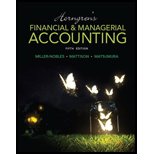
Concept explainers
Available-for-sale investments:
Available-for-sale investments are the investments in debt or equity securities, where the investor wishes to holds less than 20% of voting stock, and neither referred as trading or hold-to-maturity investments. For debt securities, the investor do not wish to hold it till maturity, and hence reported either as current assets or as long-term assets in the
Unrealized-gain or Unrealized-loss:
Unrealized-holding gain or loss occurs when the investor company record the investments at its fair value, in its financial statements, without disposing (selling) them. When the cost of the investment is lesser than the fair value of the investment, then it is unrealized-gain. On the contrary, when the cost of the investment is greater than the fair value of the investment, then it is unrealized-loss.
To determine: The value that will be reported in the net income for the adjustment, if any.
Want to see the full answer?
Check out a sample textbook solution
Chapter 10 Solutions
Horngren's Financial & Managerial Accounting (5th Edition)
 Intermediate Accounting: Reporting And AnalysisAccountingISBN:9781337788281Author:James M. Wahlen, Jefferson P. Jones, Donald PagachPublisher:Cengage Learning
Intermediate Accounting: Reporting And AnalysisAccountingISBN:9781337788281Author:James M. Wahlen, Jefferson P. Jones, Donald PagachPublisher:Cengage Learning Managerial Accounting: The Cornerstone of Busines...AccountingISBN:9781337115773Author:Maryanne M. Mowen, Don R. Hansen, Dan L. HeitgerPublisher:Cengage Learning
Managerial Accounting: The Cornerstone of Busines...AccountingISBN:9781337115773Author:Maryanne M. Mowen, Don R. Hansen, Dan L. HeitgerPublisher:Cengage Learning Survey of Accounting (Accounting I)AccountingISBN:9781305961883Author:Carl WarrenPublisher:Cengage Learning
Survey of Accounting (Accounting I)AccountingISBN:9781305961883Author:Carl WarrenPublisher:Cengage Learning Financial Reporting, Financial Statement Analysis...FinanceISBN:9781285190907Author:James M. Wahlen, Stephen P. Baginski, Mark BradshawPublisher:Cengage Learning
Financial Reporting, Financial Statement Analysis...FinanceISBN:9781285190907Author:James M. Wahlen, Stephen P. Baginski, Mark BradshawPublisher:Cengage Learning



